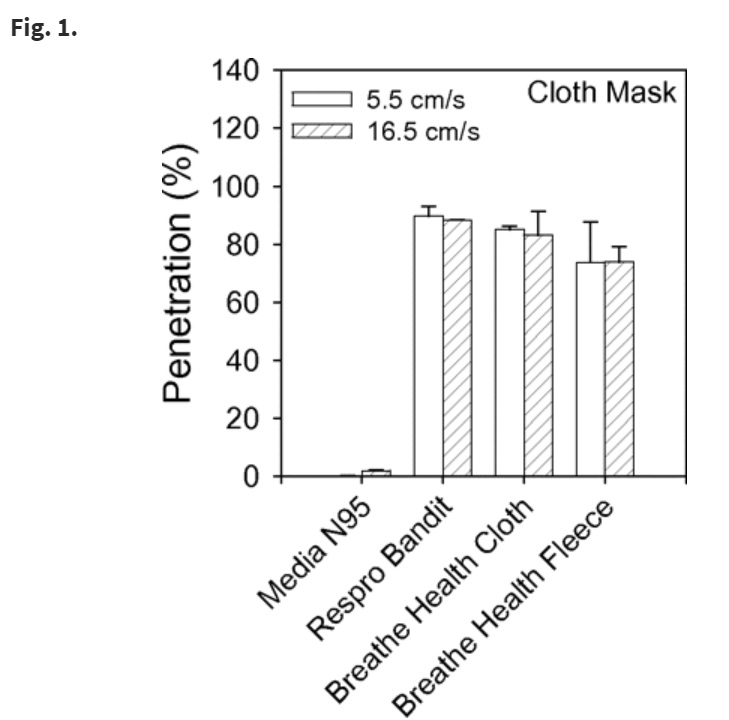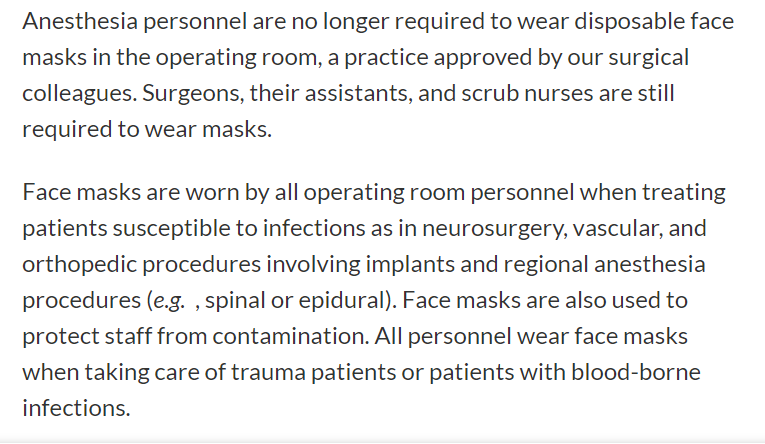Mask wearing - is it effective?
I see the anti-mask crowd has latched onto a few studies to support the "masks don& #39;t help" train of thought.
As a data scientist however, I caution that none of these studies reached that conclusion and in most cases imply the exact opposite 1/14
I see the anti-mask crowd has latched onto a few studies to support the "masks don& #39;t help" train of thought.
As a data scientist however, I caution that none of these studies reached that conclusion and in most cases imply the exact opposite 1/14
First: "25903751"
This study randomized which wing of a hospital used medical masks (presuming N95 type) and which used cloth masks.
Relative Risk (of contracing influenza w/in 4 weeks):
•cloth mask: 13%
•medical mask: 6.64%
https://pubmed.ncbi.nlm.nih.gov/25903751/ ">https://pubmed.ncbi.nlm.nih.gov/25903751/...
This study randomized which wing of a hospital used medical masks (presuming N95 type) and which used cloth masks.
Relative Risk (of contracing influenza w/in 4 weeks):
•cloth mask: 13%
•medical mask: 6.64%
https://pubmed.ncbi.nlm.nih.gov/25903751/ ">https://pubmed.ncbi.nlm.nih.gov/25903751/...
Conclusion of 25903751 is limited to "cloth masks are not as effective as medical masks" - it did not test for reducing transmission vs no-mask.
They suggest that reusing a cloth mask may increase risks, but this was not tested.
https://pubmed.ncbi.nlm.nih.gov/25903751/ ">https://pubmed.ncbi.nlm.nih.gov/25903751/...
They suggest that reusing a cloth mask may increase risks, but this was not tested.
https://pubmed.ncbi.nlm.nih.gov/25903751/ ">https://pubmed.ncbi.nlm.nih.gov/25903751/...
Second: "M20-1342"
This study had patients cough into petri dishes without a mask, with a surgical mask, and with cloth mask.
Viral load for each:
•no mask: 2.56
•surgical mask: 2.42 (94%)
•cotton mask: 1.85 (72%)
https://www.acpjournals.org/doi/10.7326/M20-1342">https://www.acpjournals.org/doi/10.73...
This study had patients cough into petri dishes without a mask, with a surgical mask, and with cloth mask.
Viral load for each:
•no mask: 2.56
•surgical mask: 2.42 (94%)
•cotton mask: 1.85 (72%)
https://www.acpjournals.org/doi/10.7326/M20-1342">https://www.acpjournals.org/doi/10.73...
Conclusion: Cotton mask > surgical mask > no mask
•did not test for reducing transmission or contaminant dispersal beyond the petri dish (duration airborne or surface area covered)
•cloth masks catch some (25%) of the viral load when coughing
https://www.acpjournals.org/doi/10.7326/M20-1342">https://www.acpjournals.org/doi/10.73...
•did not test for reducing transmission or contaminant dispersal beyond the petri dish (duration airborne or surface area covered)
•cloth masks catch some (25%) of the viral load when coughing
https://www.acpjournals.org/doi/10.7326/M20-1342">https://www.acpjournals.org/doi/10.73...
Third: "202744"
Studied which fabrics (if any) make the best homemade mask for protecting its wearer by measuring its ability to prevent very small particles (such as aerosalized COVID-19) from reaching the exterior of the mask.
https://academic.oup.com/annweh/article/54/7/789/202744">https://academic.oup.com/annweh/ar...
Studied which fabrics (if any) make the best homemade mask for protecting its wearer by measuring its ability to prevent very small particles (such as aerosalized COVID-19) from reaching the exterior of the mask.
https://academic.oup.com/annweh/article/54/7/789/202744">https://academic.oup.com/annweh/ar...
Conclusion: homemade cotton masks are as effective as surgical masks and dust masks at protecting the wearer (which is not very much at all) but they do provide a decent amount of airflow resistance which reduces contaminant spread (how far it travels)
https://academic.oup.com/annweh/article/54/7/789/202744">https://academic.oup.com/annweh/ar...
https://academic.oup.com/annweh/article/54/7/789/202744">https://academic.oup.com/annweh/ar...
Fourth: "2085803"
Studied effectiveness on common surgical masks by "non-scrubbed" personnel in the operating room.
https://anesthesiology.pubs.asahq.org/article.aspx?articleid=2085803">https://anesthesiology.pubs.asahq.org/article.a...
Studied effectiveness on common surgical masks by "non-scrubbed" personnel in the operating room.
https://anesthesiology.pubs.asahq.org/article.aspx?articleid=2085803">https://anesthesiology.pubs.asahq.org/article.a...
Conclusion: Not much to go by in this one other than they decided that anesthesiologists and similar do not need to wear surgical masks except for certain high risk patients and procedures
https://anesthesiology.pubs.asahq.org/article.aspx?articleid=2085803">https://anesthesiology.pubs.asahq.org/article.a...
https://anesthesiology.pubs.asahq.org/article.aspx?articleid=2085803">https://anesthesiology.pubs.asahq.org/article.a...
The question remains, however, is the amount of decreased contamination enough to reduce transmission or severity?
While that answer is still TBD, any efforts that reduce airborne and physical contamination should reduce the number of exposures and the viral load of each.
While that answer is still TBD, any efforts that reduce airborne and physical contamination should reduce the number of exposures and the viral load of each.
In summation:
1-none of these articles concluded wearing a mask is not helpful
2-the first, second, and third article each proved that masks reduce both airborne and physical contamination by capturing some of the virus
1-none of these articles concluded wearing a mask is not helpful
2-the first, second, and third article each proved that masks reduce both airborne and physical contamination by capturing some of the virus
Given the lack of any studies testing the theory directly, we are left to infer effectiveness based on observations, such as:
1-reducing contaminated area reduces likelihood for transmission
2-cloth masks capture some of the germs (see #1)
3-cloth masks reduce velocity (see #1)
1-reducing contaminated area reduces likelihood for transmission
2-cloth masks capture some of the germs (see #1)
3-cloth masks reduce velocity (see #1)
For visual illustration of the relevance of velocity, consider this @MythBusters demonstration of how velocity affects how far a sneeze travels https://www.youtube.com/watch?v=0f4sUNWkq60">https://www.youtube.com/watch...
For visual illustration of germ capture, consider this @MythBusters demonstration comparing how a hand, hanky, or an elbow capture a cough.
Note: this only shows that at least SOME of the virus is contained, not all of it https://www.youtube.com/watch?v=3vw0hIs2LEg">https://www.youtube.com/watch...
Note: this only shows that at least SOME of the virus is contained, not all of it https://www.youtube.com/watch?v=3vw0hIs2LEg">https://www.youtube.com/watch...
@threadreaderapp Unroll please.

 Read on Twitter
Read on Twitter












